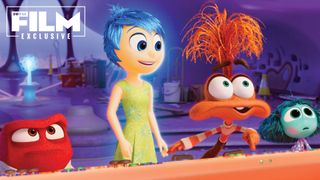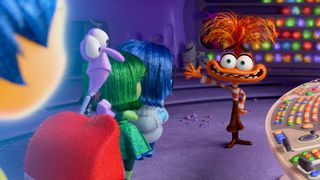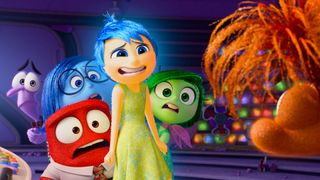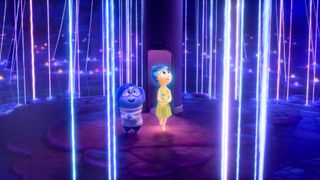There’s a video-game character in Inside Out 2… and five other things we learned on a visit to Pixar
New characters, rejected emotions, and more...

In April 2024, Total Film visited Pixar Animation Studios in Emeryville, California to watch the first 30 minutes of upcoming sequel Inside Out 2, and to delve into the minds of some of the people who have helped to make it.
Inside Out opened in 2015, and remains a top-tier Pixar offering (in Total Film’s ranking of the Films of the 2020s, it was the highest-placed animation at #8 on the list). It was a critical and commercial smash, with 98% on Rotten Tomatoes and more than $850m at the box office, and the concept of personified emotions at work inside the mind of a young girl swiftly became embedded in the public consciousness.
It was a concept that clearly had room to expand – the final minutes of the film dip into other characters’ minds, hinting at the potential to explore – and the film ends on a line that perfectly tees up a sequel. As lead emotion Joy (Amy Poehler) says, "After all, Riley's 12 now. What could happen?"

Nine years later, we’re finally going to find out, as Inside Out 2 picks up with Riley a year on. Now 13, she’s embarking on hockey tryouts for a new team, and dealing with friendship drama, cooler older players and the onset of unexpected feelings that arrive as puberty kicks in. So alongside Joy, Sadness, Anger, Fear and Disgust, new emotions including Embarrassment, Envy, Ennui and, most notably, Anxiety arrive at the console, which is now wider, features more buttons, and is extra-sensitive to handle… There's an exclusive pic of Anxiety at the controls above, taken from the upcoming issue of Total Film (which has Twisters on the cover).
In some (literally) mind-expanding world-building, we also get to see Riley’s belief system, out of which come the tenets she holds to be true, and we’ll also see the emotions visit the vault where secrets are kept.
Pixar’s Steve Jobs Building is an unbelievably exciting workplace to visit, inspiringly full of concept art, cool little details, a fair few Oscars, and a whole bunch of creative craftspeople at the top their game. Read on for several cool things we gleaned from our visit…
Inside Out 2 features a videogame character

Inside the aforementioned vault of secrets, you’ll meet Bloofy, a 2D-animated dog from a favourite pre-school show of Riley’s, as well as Lance Slashblade, a Final Fantasy-style character who also lurks down there. Lance (voiced by Yong Yea) is an amusingly pixel-y creation who's prone to glitching and is at odds with the slick, vibrant animation that comes as standard elsewhere in the film. He’s one of the humor highlights of the footage screened, mining a similar source of laughs to Keanu Reeves’ Duke Caboom in Toy Story 4.
Sign up to the GamesRadar+ Newsletter
Weekly digests, tales from the communities you love, and more
TF had the chance to ask director Kelsey Mann about the inspiration behind the character. "You know where he came from?" explains Mann. "When you’re a teenager, when you’re not dating, you start to develop crushes. And sometimes they’re not just on people; they’re on cartoon characters. That’s speaking from experience! Or videogame characters. We thought, ‘Oh, that would be so great. Riley could have a crush on a videogame character. We could animate that character like he’s from a videogame, and have that kind of look – that kind of pixelated look.' We were like, 'That could be really fun to do, and hopefully something that’s really relatable to a lot of people.'"
As production designer Jason Deamer adds, that kind of ‘bad’ animation can be more difficult for Pixar than their usual high-end output. "Those were the hardest things, because I think for Lance, we had 12 meetings before they’d even built anything," says Deamer. "And it’s because, you know, we’re really good at doing three-dimensional [animation]… We have a pipeline. It’s a well-oiled machine." That’s not the case when you’re animating outside of the box.
Maya Hawke’s Stranger Things role helped her to get cast

While it might seem like some animated films target A-list names over character actors, producer Mark Nielsen explains that all of the voice casting is done ‘blind’, where they listen to options without knowing who the actor is. "Our casting team played a bunch of options of people to consider for the voice of Anxiety," he says. "They just say ‘actor one’ and ‘actor two’, and we just look at an image of the character, because that’s what they’re going to look like on the screen, and just see if the voice fits.
"And, man, the second we heard Maya, and it was clips probably pulled from Stranger Things and some other things she’d done – she’s got this amazing ability to talk really, really fast, and say a thousand words in three seconds. And there’s just a nervous energy to it that we picked up on in some of her clips, and we were like, 'She could be brilliant at this.'"
There was almost a Jealousy emotion

Other new voices include Paul Walter Hauser as Embarrassment, Adèle Exarchopoulos as Ennui, and The Bear’s Ayo Edebiri as Envy. "Envy is one of my favourite new characters," says Mann. "It took a lot of development to get Envy. In fact, we even had Jealousy in the movie. I almost had them be twins, so that no one could ever tell the difference between the two of them. But Envy is the feeling that you wish you have what others have."
All of the emotion designs begin with a simple color and shape, so it made sense that Envy would be small, wide-eyed, and green. "[With] Envy, we were like, 'She should be the smallest one!'" says Mann. "Because she wishes she was as tall as everyone else. She wishes she could reach the console like everybody else can. We knew she could barely reach the console. So she came together pretty quickly when we went down that direction."
Shame was almost an ‘archvillain’

Jealousy wasn’t the only emotion that didn’t make the sequel – there were also plans to include Shame as an antagonist at one point. "She was cut out of the movie," recalls Deamer. "There was Shame and she was one of the original villain kind of [characters]."
But there were two problems with this particular idea, they found. "One, she was just too arch, and one-dimensional: 'Aargh, I’m evil Shame!' And the other thing, Dacher Keltner [professor of psychology at the University of California, Berkeley] who helped out with the first film, told us that shame is not really considered an emotion as much as a state of mind… Not everyone has shame. The thing about emotions is, according to [Keltner] – and he’s the guy who wrote the original book, and he’s the expert in the country on it – we all have joy and sadness. Not everybody has shame. So that’s why it’s considered a state not an emotion. I love the [concept drawing of Shame, though] – great design."
The world of the film is growing, and so is the aspect ratio

While the world of Inside Out 2 expands as we discover more about the recesses of Riley’s mind (and as her social horizons start to expand), things are getting bigger in another literal sense with the filmmakers embracing widescreen, as the film is presented in the wider 2.39:1 aspect ratio, compared to the original film’s 1.85:1.
"One of the things that’s really exciting about the film is that we now have this widescreen canvas," says director of photography Adam Habib. "The whole idea that we had in the first film was that the human-world camera, which is Riley’s story, would have a lot more tactile imperfection and a physical quality to it – and the mind-world camera, Joy’s world, is almost like a virtual camera. Sometimes we talked about it like a 1930s studio – a very smooth and precise kind of camera. With the new widescreen format of Inside Out 2, we took that a little bit further by making the human world camera an anamorphic lens. So it’s just a little more texture, a little more detail."
Unused ideas from the first film got a chance to shine

As you witness when you tour Pixar, ideas are everywhere. Every film is the result of input from an almost countless number of artists and contributors, and the films are repeatedly honed across a production cycle that lasts approximately four years per movie. So it goes without saying that there are far more ideas than can ever make the final cut. All of Pixar’s movies are screened in very rough storyboard format several times over as the story is being refined. And so Mann was able to dig into the archives for some rather useful pointers.
"When we make our movies here, we always have a screening where we storyboard the whole movie, and we cut it together, and we watch it in a theatre. We pretty much do that every three months or so. One of the first things I did [when I started working on Inside Out 2] was, I watched every single screening [of Inside Out]. I watched screening one, two, three, four, five – I watched all of them. Because a lot of times, an idea gets cut not because it’s a bad idea but because it didn’t quite fit the story. And so there was a lot of stuff that we left on the table from the first film that I can mine from, and that I can bring back into the sequel."
Mann also looked over all of the art from the original film, too, "because there was a lot of stuff explored. But there were so many good ideas. And there’s going to be ideas – I can tell you right now, for this film – that are really great ideas that are going to be put on the shelf, and who knows what will happen in the future? But there’s definitely a ton of great ideas that I mined from to do this movie."
- Inside Out 2 opens in cinemas on June 14. Read more about the film in the new issue of Total Film, which hits stands on Thursday, May 23.

Pre-order the issue here to bag your copy or click here to subscribe to Total Film and never miss another exclusive: you’ll get all this movie goodness throughout the year before it’s in shops, as well as having exclusive covers and saving money on the cover price. With our latest offer, you can save up to 35% and you’ll get a mystery gift - and to sweeten the deal, subscribers now get a brand new bonus too, with access to more than 10 years' worth of digital back issues as part of the subscription. That’s well over 100 issues you can explore, including our most recent issues. What’s not to like?


I'm the Editor at Total Film magazine, overseeing the running of the mag, and generally obsessing over all things Nolan, Kubrick and Pixar. Over the past decade I've worked in various roles for TF online and in print, including at GamesRadar+, and you can often hear me nattering on the Inside Total Film podcast. Bucket-list-ticking career highlights have included reporting from the set of Tenet and Avengers: Infinity War, as well as covering Comic-Con, TIFF and the Sundance Film Festival.
Most Popular




